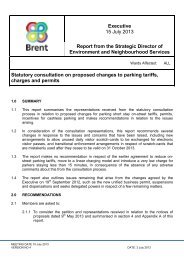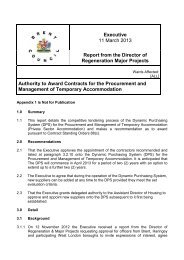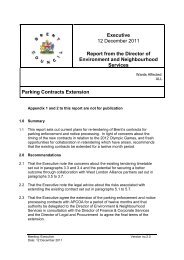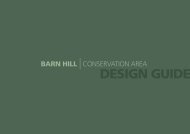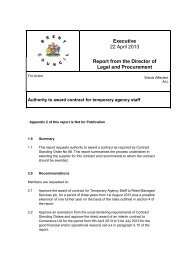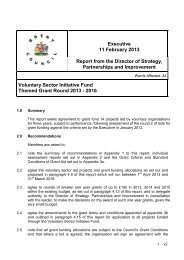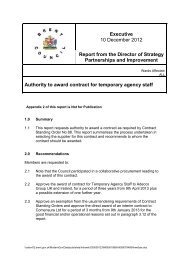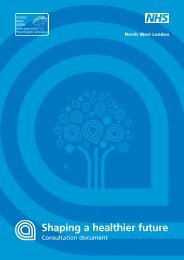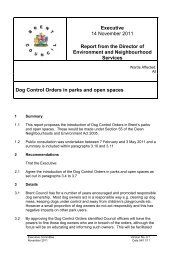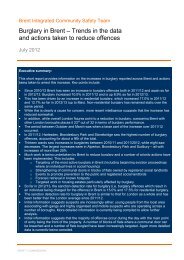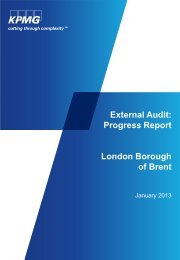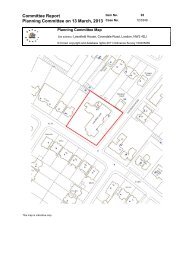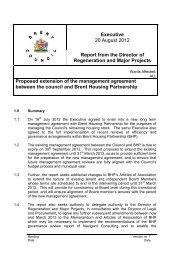wembley-plan-app (small) , item 9. PDF 8 MB - Meetings, agendas ...
wembley-plan-app (small) , item 9. PDF 8 MB - Meetings, agendas ...
wembley-plan-app (small) , item 9. PDF 8 MB - Meetings, agendas ...
- No tags were found...
Create successful ePaper yourself
Turn your PDF publications into a flip-book with our unique Google optimized e-Paper software.
Wembley Area Action Plan - Proposed Submission Version151Appendix B: Glossary 19in any specified way; or require payments to bemade to the <strong>plan</strong>ning authority either in a singlesum or periodically. Planning obligations may becreated by agreement or by unilateral undertakingson the part of the developer/ owner of the land.Sequential ApproachThe National Planning Policy Frameworkencourages the effective use of land by reusingland that has been previously developed (brownfieldland), provided that it is not of high environmentalvalue. A sequential test should be <strong>app</strong>lied to<strong>plan</strong>ning <strong>app</strong>lications for main town centre usesthat are not in an existing centre and are not inaccordance with an up to date Local Plan. Thesequential <strong>app</strong>roach requires the allocation ordevelopment of certain types or locations of landbefore others e.g. town centre locations beforeedge of centre locations before out of townlocations.Sites of Importance for Nature ConservationA series of sites identified by the Greater LondonAuthority and Brent Council that represent the bestwildlife habitats and nature conservation sites inthe borough. Sites are classified into Sites ofMetropolitan, Borough (Grade I and II) and LocalImportance for Nature Conservation.Social InfrastructureCovers facilities such as health provision, earlyyears provision, schools, colleges and universities,community, cultural, recreation and sports facilities,places of worship, policing and other criminal justiceor community safety facilities, children and youngpeople’s play and informal recreation facilities.Strategic Cultural AreaAn area with internationally important culturalinstitutions, which are also major tourist attractions.Strategic Industrial Location (SIL)Coherent areas of land within the main industrialestates which are, in terms of environment, roadaccess, location, parking and operating conditions,well suited for retention in industrial use.Supplementary Planning Document (SPD)Guidance additional and supplementary to the LocalDevelopment Framework on how to implement itspolicies, similar to the former SupplementaryPlanning Guidance for the UDP.Sustainable DevelopmentDevelopment which meets the needs of the presentwithout compromising the ability of futuregenerations to meet their own needs andaspirations (Resolution 42/187 of the United StatesGeneral Assembley)Sustainable Urban Drainage System (SUDS)SUDS is an alternative <strong>app</strong>roach to conventionalurban drainage which have been developed to copewith drainage water in an environmentally saveway. SUDS can reduce pressure on the existingdrainage systems, prevent or reduce the likelihoodof flooding and may also help clean up pollutantsin run-off.Tall BuildingsBuildings or structures that are more than 30 metresin height or significantly taller than surroundingdevelopment.Transport nodesMajor transport interchanges, where people caneasily transfer from one mode of transport toanother. i.e. where buses, mainline rail services,and tube lines meet.Travel Plans (Sometimes called Green Travelor Commuter Plans)A document submitted as part of a transport impactassessment setting down proposed measures bythe developer to deliver sustainable transportobjectives, including: measures for reducing carusage (particularly single occupancy journeys) &promoting and securing increased use of walking,cycling and public transport.Waste HierarchyThe order of the most desirable waste managementoptions, in which the prevention and reduction ofwaste are prioritised, then the reuse and recyclingoptions and lastly the optimisation of its finaldisposal. The concept is described by the “3Rs” –Reduce, Reuse, Recover – followed by unavoidabledisposal.



